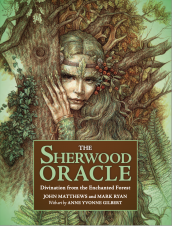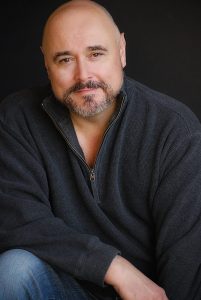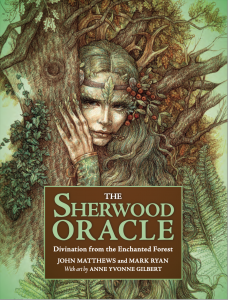THE SHERWOOD ORACLE is a boxed set of book, cards and map. Co-created by Mark Ryan and John Matthews, with artwork by Anne Yvonne Gilbert, this is an oracle deck rather than a tarot deck, although there are similarities.
Ryan has already co-created two highly popular tarot decks, THE WILDWOOD TAROT, also in collaboration with Matthews, with artwork by Will Worthington, and THE GREENWOOD TAROT, in collaboration with artist Chesca Potter.
Additionally, Doncaster, England native Ryan is the writer and composer of a musical version of WUTHERING HEIGHTS and a former member of the British Special Forces. He was the late Bob Anderson’s assistant sword master on FIRST KNIGHT and sword master on KING ARTHUR.
As an actor, Ryan originated the role of Magaldi in the premiere West End production of EVITA, then moved up to playing Che (and had a small role in the feature film version), voiced multiple characters, including Bumblebee and Lockdown, in the TRANSFORMERS film (as well as being supplying the on-set voices for all the Transformers during shooting), and costarred as pirate quartermaster Mr. Gates on BLACK SAILS, now streaming on Netflix.
Additionally, Ryan played Nasir, the first known Saracen Merry Man, in ROBIN OF SHERWOOD. The Herne’s Arrow convention in Wales, May 18-19, will observe the fortieth anniversary of the launch of the TV series. The event has been sold out for nearly two years (though some day tickets are available). Ryan, as well as most of the regular cast, some of the guest cast, creatives and crew, will be in attendance.
The lore of Sherwood Forest clearly plays a key role in THE SHERWOOD ORACLE. Ryan gets on a Zoom call to discuss the new project.
“John originally suggested this,” Ryan begins. “We both obviously deeply care for the whole forest ethos, and particularly ROBIN OF SHERWOOD, and that came back into our consciousness. We went, ‘Well, why don’t we look at the concept of doing an oracle, which the person themselves can actually use at home without necessarily having to talk to a tarot reader, and get results and answers from it?’ So, we layered it in a way that you’ve got various ways that you can look at the various characters, including the locations, which is why the map is there.
“But also, you’ve got the trees and what characters are defined by certain trees, and you’ve got people that are opposing what you’re trying to do. You’ve got a lot of avenues to pursue in terms of information that can be gleaned from a reading. There are actually fewer cards [than in a tarot deck]. There are twenty-five Major Character cards, so it’s a little bit easier to handle and to remember what means what, and you’ve got ten place cards, which have all got a frequency of their own. So, it seemed like a nice idea.”
Ryan gives a shoutout to editor Kate Zimmerman at THE SHERWOOD ORACLE’s publisher, Sterling Ethos, “who has been a great supporter of WILDWOOD, and they distribute WILDWOOD in the United States. We pitched this idea to her with some sample artwork by Anne Yvonne Gilbert, and she went, ‘Yes!’ At the moment, in the publishing world, particularly in the U.K., getting any kind of response is difficult,” he laughs, “so getting a positive response was very welcome.”
THE SHERWOOD ORACLE is not a tarot deck, Ryan explains. What is the difference? For starters, in a tarot deck, “You’ve got seventy-eight cards, and you’ve got a lot of other imagery within the cards, which people can make of as they will. As tarot evolves, I’ve discovered that not only do people actually mix and match tarot cards from different decks, but they actually mix and match the way that they read them. Which is fine by me. I think that you should be able to do that and play with the system. One of the things I wrote in the original GREENWOOD book was, ‘Read the book, play with the cards, then put the book down and do what you want to do.’
“The same is true of the ORACLE, but the ORACLE deck is slightly different. John and I had been talking about this for at least probably five years, about what we were going to follow up WILDWOOD with. Having done two tarot decks, I was looking at doing something else. But obviously, I resonate to these natural frequencies pretty easily. And then when John came up with the concept of an oracle, it was like, ‘Okay, it’s different.’
“The difference is, the actual person who buys the deck can do it themselves, whereas with a lot of tarot decks, you need a tarot reader to interpret the layout, and what they’re actually seeing. In the book, we’ve made it really easy.”
Ryan holds up the full-color map that accompanies the ORACLE deck. He says he tends to use the map as a replacement for a particular tarot spread, “the bow spread, which I use. Anybody wants to try [the bow spread with the ORACLE deck] and tell me what results they get, I’m fascinated to hear.”
When he does a reading for someone else, Ryan doesn’t want to know their question beforehand. Sometimes, a person will get the same answer repeatedly, reinforcing the answer. “An oracle, like a tarot deck, is a living thing, based on the psychological archetypes. And the concept that I believe in, although you don’t have to believe in this, because it works in different ways, is that the universe has a thinking conscious field, and what you put into it, you get a response to. So, when you ask a question, you create a void, into which, for some reason, the conscious universe, based on Robert Sheldrake’s concept of the morphic field, will bring you an answer. That is why sometimes you have to be disciplined about what you ask, because you will get some kind of response from the universe, and you want to obviously have a response that you can understand.”
Oracle decks, distinct from tarot decks, are something that, Ryan explains, have “developed over the last few years.” Prior to creating THE SHERWOOD ORACLE, “I hadn’t really done much studying on the decks that call themselves oracle decks. However, the idea of doing an oracle deck, conferring with the archetypes of the Robin Hood mythos, is not a big step, because the archetypes are so strong, and so popular, and so accessible.
“I think sometimes stuff gets a little bit too esoteric, and it’s difficult to access what the author and the artist are trying to express in the cards themselves. Whereas this is something that most people understand the history of, even though they might not have thought of it as an oracle. They might have thought of it as just as Errol Flynn, or ROBIN OF SHERWOOD or PRINCE OF THIEVES or any related idea conceptualized in the Robin Hood mythos. To me, though, it doesn’t matter.”
What was the division of labor between Ryan and Matthews in creating the deck?
“We agreed very early on that I would focus on the practical applications of some of this, because I like it to be practical. And so, water, shelter, fire, and food, the practicalities of actually living in a forest. I wanted to relate those spiritually to a concept like this. Obviously, water is an elemental thing in tarot cards. So, I concentrated on those parts of the book, and those parts of the concept.
“John is an expert on the historical poems, and the original stories, and the characters. He’s written books about the historical Robin Hood. And then, we read each other’s stuff, and went, ‘It resonates.’ So, that was how it went. We both worked on the characters, we both worked on the places, but John tended to work more on the esoteric linkages between the characters and the trees, and some of the places, and how that related to the legends that had been written over the years, and I tended to concentrate on, how does it work? What would you need to live in the forest as an outlaw, and how does that relate to the esoteric concepts that we try to delve into here?”
Anne Yvonne Gilbert did the artwork for the deck. “Her artwork is not just legendary, it’s award-winning, stunning. Her detail is amazing. We conferred with her [and found] that we could all work together, which, again, is another element when you’re developing these things. You really have to trust each other, and be able to get into that flow.
“That was a different relationship than we had with Will Worthington [the artist for WILDWOOD]. We gave Will very detailed briefs, and he came back with some amazingly rich, deep, esoterically emboldened, and filled with all these different symbols, which was brilliant. Working with Yvonne, we didn’t have to do much. We gave her a brief of what we were doing. We looked at some of the original pencils that she did, and we went, ‘Go for it.’
“If you look at her renditions of Marian and the Green Lady and the Green Man, various other drawings, it didn’t need a lot of work [from Ryan and Matthews] for her to bring forward what we were imagining. It was very easy. If there’s a lot of work to be done, it usually means that something’s not quite jelling. But she’d already done some artwork for a previous Robin Hood project, which I saw, and I thought, ‘She’s tuned in. She’s there.’”
How did the creators decide who the characters for THE SHERWOOD ORACLE should be? There are the classic Robin Hood characters – Robin Hood, Marian, Little John, etc. – but there are also characters from British folklore like the Green Man and the Green Lady. And there’s a card for a character who only became part of the Robin Hood legend with ROBIN OF SHERWOOD, though Arabic figures have cropped up often in subsequent screen adaptations: the Saracen.
Ryan acknowledges with a laugh, “People may go, ‘He wasn’t in the legend.’ Well, I could bore for Britain about why, in the Middle Ages, there was plenty of Arabic influence in England.” In fact, Ryan points out, due to the Crusades in the Middle East, a lot of Crusaders came back to England with Arabic translators, medics and other aides in tow. “There’s a real historical precedent why that fits. And it works.
“Other characters that you’ll see within these twenty-five cards, including John Barleycorn, are from British traditional wildwood-type legends. Once we’d actually got our twenty-five characters, it was easy. There’s even a card related to Doncaster, my place of birth.”
Unlike the other cards, which are visually steeped in folklore, the David of Doncaster card depicts a shirtless fellow perhaps best described as a “dude.” Ryan laughs, “My argument has always been there is David of Doncaster, and if you go to Doncaster Town Center on a Friday night, you’re probably going to meet somebody like this.” More seriously, “I believe he’s in one of the original poems about Robin Hood. Doncaster was a major crossing point for the Romans on their journey north to Scotland.
There are also place cards that extend beyond Sherwood. “I know people are going to go, ‘Well, Wayland’s Smith is not in Sherwood Forest.’ No, it’s not. However, when I was doing GREENWOOD and WILDWOOD, Wayland’s Smith [where the smith Wayland supposedly forged magical weapons] always resonated with me, and was a place where I could tune in quite easily. And so, as we’d used Wayland and the swords of Wayland in ROBIN OF SHERWOOD, it seemed a natural thing. There’s a reason why [ROBIN OF SHERWOOD series creator Richard] ‘Kip’ Carpenter did that. There’s a resonance to the concept of Wayland the Smith and the swords.”
Each character in the deck corresponds to a specific type of tree. How did they decide which trees went with which characters?
“I think the tree represented what we saw most in the elements within the actual characters. Yew was used a lot for making longbows, and somewhere in my childhood memory, I seem to remember that yew trees that grew within a graveyard were not allowed to be cut down. We chose the wood that most resonated with the character that we were looking at. John did most of that work, because he knows a lot about that part of it.”
Ryan adds that the artwork on THE SHERWOOD ORACLE is perhaps more straightforward than that of a conventional tarot deck. “I would say more what you see is what you get. There are little Easter eggs of meaning attached to each character. But in the artworks, although they are incredibly rich, there’s no hidden symbolic meaning within them. The concept was for the person that’s reading for themselves to directly interact with the archetype, as opposed to trying to decode the mystical aspects. And what I liked about this was that you are dealing with characters that were already well-known.
“Again, it’s a slightly different frequency. With this deck, you’re actually directly interacting with the imagery of an archetype, and you yourself have a personal relationship to that. It’s not looking at the greater esoteric plan of a tarot card, where within the tarot card, there are little symbols related to the frequency of the four elemental kingdoms. When you go to the [ORACLE] Green Man, the male element within the forest, there are many ways that that has been interpreted in art – the foliate face, the greenery growing out of the mouth, being the father of that type of fecundity. But you’re dealing directly with that, as opposed to it being surrounded by a lot of other esoteric information, which some people find confusing.
“And that is one of the fundamental differences. My interpretation of this is, we make our own fate. A tarot card can’t tell you the future. You are in charge of that, you are responsible for that, and THE ORACLE is the same. So, fundamentally, that is the same. The mechanism is slightly different.
“All of these systems, whether they’re oracles or tarots, are a reflection of what is going on for you. It’s a snapshot, it’s a slice in time, of where you are, regarding any issue. The fact that you are looking at it, and studying it, and asking questions, changes the outcome. That can be subconscious, or it could be conscious. In THE ORACLE, we have laid that out in the book, chapter and verse.”
“As I’ve said about tarot in the past, the reason that there are so many types of tarot systems and decks and images is that we’re all individual human beings, and we all react to certain archetypes the way that we do culturally, historically, sexually, whichever way you want to look at it. Some work really well. That doesn’t mean it’s set in concrete.
“With THE ORACLE, what we’ve done in the book is laid out more detailed responses, more compressed, within a smaller deck. However, you’ve got multiple ways to interpret it. And as soon as you do interpret it, and you look at it and go, ‘Well, maybe I won’t paint the garage door orange after all, because it might upset the neighbors,’ you’ve already changed the reality.
“So, it’s more about accessibility to certain people. Some people will always stay with tarot cards, because they’re accessible to them. This will be accessible to a different level of people. Many that have never picked up a tarot deck, or even been interested in esoteric pursuits, will look at this and go, ‘Oh. I understand what that means,’ and go in that direction. Whatever works for you, whatever you look at and go, ‘Yeah, okay, I’ve got a decent response,’ that to me is what is positive.”
On the filmmaking front Ryan, is involved in helping to produce a Dutch narrative feature, 23 LETTERS FROM VINCENT VAN GOGH, about the artist’s time in Drenthe. “It’s very rural, wild. During the period that he was there, it was very poor. People literally lived in mud huts and grass houses. He was fascinated by this, and he spent much time out there, painting people at work, farmers and laborers.”
Ryan plays a man called McGeraghty, “which we discovered was actually part of my family history in Ireland, the McGeraghty clan. This character who is a card reader and a magician, who is outlawed in Ireland, and he ends up in Drenthe, reading Vincent van Gogh’s tarot cards. We’ve commissioned a series of cards which are of the period, but based on the elements of THE GREENWOOD TAROT deck.”
There is also a long-in-development feature project about whether Joseph of Arimathea brought Jesus Christ to Britain. And, to bring things full Sherwood circle, there is the upcoming Herne’s Arrow ROBIN OF SHERWOOD event.
“We are celebrating in May the fortieth anniversary of the launch of this, and our friendships that have endured all these forty years.”
Follow us on Twitter at ASSIGNMENT X
Like us on Facebook at ASSIGNMENT X
Article Source: Assignment X
Article: Exclusive Interview: THE SHERWOOD ORACLE co-creator Mark Ryan on card, deck and book box set
Related Posts:













